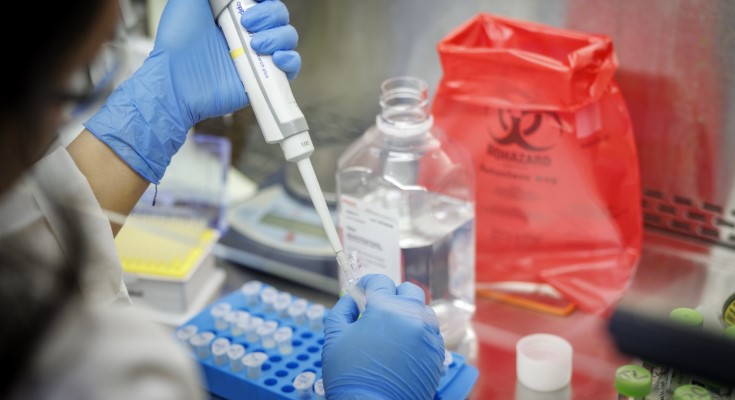World
Pennsylvania Bolsters Biosecurity Amid Avian Influenza Threat

State agriculture officials in Pennsylvania are intensifying their efforts to combat the ongoing threat of avian influenza, which poses a significant risk to the state’s poultry industry valued at approximately $7.1 billion. On Tuesday, Deputy Secretary for Animal Health and Food Safety, Lisa Graybeal, highlighted the importance of the state’s veterinary laboratories during a tour of the Pennsylvania Veterinary Laboratory in Harrisburg.
The announcement comes in the wake of confirmed infections at six poultry farms in Lancaster County, impacting nearly 58,000 birds. Since the outbreak of Highly Pathogenic Avian Influenza (HPAI) began in February 2022, Pennsylvania has suffered the loss of more than 7.1 million birds across 100 flocks in 23 counties, marking one of the largest animal health crises in the state’s history.
Investments in Testing and Biosecurity
Graybeal credited the state’s coordinated response and investments in laboratory testing for reducing losses and ensuring consumer confidence in Pennsylvania poultry products. “Testing to monitor and detect avian influenza has been an indispensable tool to minimize damage during what has been the biggest animal health crisis in American history,” she stated. “Our veterinary teams, farmers, and state partners have shown unwavering commitment to recovery and prevention.”
The state’s three diagnostic facilities in Harrisburg, University Park, and Kennett Square processed over 672,000 animal health samples in the past year. A fourth lab, currently undergoing renovation at Penn State’s Beaver Campus, is expected to enhance capacity and decrease response times. This facility is backed by a $6 million investment in the 2024–25 budget, with an additional $2 million proposed for next year’s operations.
State Veterinarian Dr. Alex Hamberg emphasized the importance of on-farm biosecurity. “When every farm has a biosecurity plan and everyone who enters follows it, disease risks are lower and recovery is quicker,” he said.
To aid producers affected by the outbreak, the Shapiro Administration has distributed nearly $15.7 million in HPAI Recovery Grants to 292 applicants, with approximately $59.6 million remaining in reserve. The administration’s budget proposal for 2025–26 includes an additional $11 million to sustain funding for recovery and prevention initiatives.
Industry Leaders Praise State Support
Industry leaders have commended the state’s ongoing support, emphasizing its critical role in ensuring the resilience of Pennsylvania’s poultry farmers. “Pennsylvania has set a gold standard for animal disease response,” said Chris Herr, Executive Vice President of PennAg Industries. “Our labs, grants, and coordinated response ensure that poultry farmers can recover and stay in business.”
Looking ahead, experts warn that the upcoming months are crucial, as migratory birds—known carriers of HPAI—will pass through the region. Renewed infections could disrupt poultry exports, tighten egg supplies, and lead to increased food prices. Nevertheless, the state’s expanded testing network and recovery funding are anticipated to mitigate the economic impact and safeguard long-term industry stability.
With poultry being one of Pennsylvania’s top agricultural sectors, maintaining consumer confidence and supporting farmer resilience is a top priority. The state’s comprehensive surveillance and funding model may also serve as a potential blueprint for other agricultural regions facing similar biosecurity challenges.
-

 Sports2 weeks ago
Sports2 weeks agoSteve Kerr Supports Jonathan Kuminga After Ejection in Preseason Game
-

 Science2 weeks ago
Science2 weeks agoChicago’s Viral ‘Rat Hole’ Likely Created by Squirrel, Study Reveals
-

 Politics2 weeks ago
Politics2 weeks agoDallin H. Oaks Assumes Leadership of Latter-day Saints Church
-

 Business2 weeks ago
Business2 weeks agoTyler Technologies Set to Reveal Q3 2025 Earnings on October 22
-

 Lifestyle2 weeks ago
Lifestyle2 weeks agoKelsea Ballerini Launches ‘Burn the Baggage’ Candle with Ranger Station
-

 Lifestyle2 weeks ago
Lifestyle2 weeks agoDua Lipa Celebrates Passing GCSE Spanish During World Tour
-

 Entertainment2 weeks ago
Entertainment2 weeks agoZoe Saldana Advocates for James Cameron’s Avatar Documentary
-

 Health2 weeks ago
Health2 weeks agoRichard Feldman Urges Ban on Menthol in Cigarettes and Vapes
-

 Health2 weeks ago
Health2 weeks agoCommunity Unites for Seventh Annual Mental Health Awareness Walk
-

 Business2 weeks ago
Business2 weeks agoMLB Qualifying Offer Jumps to $22.02 Million for 2024
-

 Sports2 weeks ago
Sports2 weeks agoPatriots Dominate Picks as Raiders Fall in Season Opener
-

 World2 weeks ago
World2 weeks agoD’Angelo, Iconic R&B Singer, Dies at 51 After Cancer Battle









